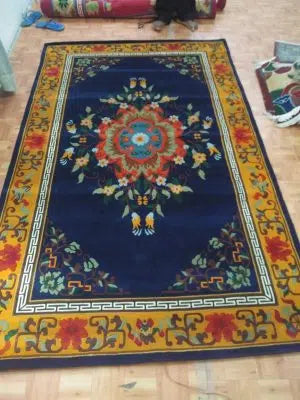
Natural Fiber Rugs
Types of Natural Fiber Rugs
1. Jute Rugs
Jute rugs are made from the fibers of the jute plant, primarily grown in India and Bangladesh. Known for their soft texture and natural golden hue, jute rugs add warmth and rustic charm to any room.
Characteristics:
- Soft and comfortable underfoot
- Biodegradable and eco-friendly
- Best suited for low-traffic areas
2. Sisal Rugs
Sisal rugs are crafted from the agave plant fibers, native to Mexico. These rugs are renowned for their durability and strength, making them suitable for high-traffic areas.
Characteristics:
- Highly durable and resilient
- Naturally stain-resistant
- Available in various weaves and patterns
- Coarser texture than jute
3. Seagrass Rugs
Seagrass rugs are made from seagrass, a marine plant found in coastal waters. These rugs are celebrated for their natural sheen and water-resistant properties.
Characteristics:
- Naturally water-resistant
- Easy to clean and maintain
- Adds a coastal or tropical feel
- Slightly coarse texture
4. Coir Rugs
Coir rugs are produced from coconut husk fibers. These durable rugs have a distinct texture, making them ideal for entryways and high-traffic areas.
Characteristics:
- Extremely durable and tough
- Naturally resistant to mold and mildew
- Coarse texture, suitable for door mats
5. Wool Rugs
Wool rugs are made from sheep's fleece. They are known for their softness, warmth, and durability, making them a timeless choice for home interiors.
Characteristics:
- Soft and plush underfoot
- Naturally flame-resistant
- Excellent insulation properties
- Available in wide color and pattern ranges
Benefits of Natural Fiber Rugs
Eco-Friendly
Natural fiber rugs are environmentally friendly, made from renewable resources and biodegradable materials. They reduce demand for synthetic materials derived from non-renewable sources.
Durability
Many natural fiber rugs, particularly sisal and coir, are highly durable and withstand heavy foot traffic, making them practical for hallways, entryways, and living rooms.
Aesthetic Appeal
These rugs offer diverse textures and colors, from jute's soft golden hues to coir's rustic look. They add a natural, organic touch that enhances interior aesthetics.
Hypoallergenic
Natural fiber rugs, especially wool, have hypoallergenic properties. They trap dust and allergens, preventing air circulation and reducing allergic reactions.
Easy Maintenance
Many natural fiber rugs are easy to clean and maintain. Seagrass and coir rugs are naturally stain-resistant and can be easily vacuumed or spot-cleaned.
Care and Maintenance
Regular Vacuuming
Vacuum regularly with a brush attachment to remove dust and debris without damaging fibers.
Spot Cleaning
Address spills immediately by blotting with a clean cloth and using mild detergent with water. Avoid harsh chemicals.
Rotation
Rotate your rug periodically to ensure even wear and prevent specific areas from becoming overly worn.
Professional Cleaning
Have your rug professionally cleaned every 1-2 years to remove deep-seated dirt and stains.
Protecting from Sunlight and Moisture
Place rugs away from direct sunlight to prevent fading. Avoid moisture-prone areas to prevent fiber damage and mold growth.
Storage
When storing, roll the rug (do not fold) and wrap it in breathable material. Store in a cool, dry place away from sunlight and moisture.
Market Trends and Value
Growing Demand for Eco-Friendly Products
Demand for eco-friendly home decor, including natural fiber rugs, has grown significantly as consumers seek sustainable alternatives to synthetic products.
Versatility in Design
Available in designs ranging from simple rustic to modern sophisticated, these rugs suit various interior styles from coastal to contemporary.
Customization
Many manufacturers offer customization options for size, shape, color, and pattern to suit individual spaces and personal styles.
Investment Value
High-quality natural fiber rugs, particularly wool, can be valuable investments that appreciate over time due to their durability and timeless appeal.
Conclusion
Natural fiber rugs offer beautiful, durable, and eco-friendly options for any home. Understanding the different types, benefits, and care requirements helps you make informed decisions that enhance your interior decor while supporting sustainable practices. Whether you prefer jute's soft texture, sisal's durability, or wool's luxurious feel, there's a natural fiber rug to meet your needs while contributing to a healthier environment.





